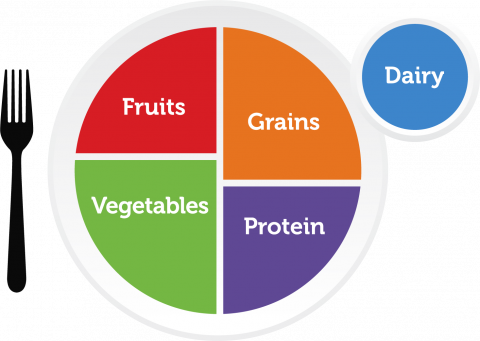Portion Control Awareness
October 1, 2024 Strategies for maintaining portion control in various settings; at home and while dining out
Strategies for maintaining portion control in various settings; at home and while dining out
It is important to become familiar with portion sizes that are appropriate for your body’s needs so that you are eating enough calories and nutrients for optimal health and longevity, and to prevent over eating which leads to unwanted weight gain. Everyone’s calorie needs and portions of different food groups does vary depending on gender, activity level, height, weight, and age, but there are general ranges that are appropriate for most people. However, your portions are going to look a little different than someone who has not had bariatric surgery due to the difference in stomach size. For more specific details on what your needs are, reach out to your bariatric dietitian to discuss.
When reading a nutrition label, the nutrient amounts listed and portion suggestions are based on an average calorie intake of 2000 calories a day. Some people need more calories than that, others need less. So, the portion size listed on the label may or may not be appropriate based on your needs and goals. As time progresses after your surgery, your calorie intake will change. If you have not yet reached your goal weight, you need to remain in a calorie deficit in order to continue losing weight. If you reached your goal weight then you no longer need to be in a calorie deficit, and now want to focus on maintenance. If you are sedentary and not doing much physical activity, you do not need as many calories or carbohydrates as someone that is exercising 4-5 times a week.
Food Scale vs. Measuring Cups
The best tool to utilize to measure your portion sizes is a food scale. Measuring the weight of food is the most accurate method and better than using measuring cups or spoons. There can be a lot of variability when using measuring cups as you can pack the cup full or fill it loosely and it will have a completely different amount of food in it and therefore calories can be inaccurate. In the early stages post-operatively, you will only be able to eat about 3 ounces of food at a time. There is some variability depending on the type of food/food density and the nutrient composition of the food (think yogurt vs. chicken, you will be able to eat more ounces of yogurt before feeling full compared to chicken). 3 ounces is about the equivalent to the size of a deck of cards, or roughly ¾ Cup.
As time goes on and you get further out from your surgery and get closer to or meet your goal weight, you will be able to eat more (about 4-6 ounces of food) at a time. For someone who is not yet at goal weight, ideally a balanced meal would look like 2-3 ounces of protein and 2-3 ounces of a non-starchy vegetable. (Example: salmon + green beans) If goal weight is met, the meal may look more like 2-3 ounces of protein, 2 ounces of non-starchy vegetable, and 1-2 ounces of a complex carbohydrate. (Example: salmon + green beans + roasted sweet potato)
Here are the daily recommendations from the Dietary Guidelines for Americans (based on 2000 calories/day):
- 2 ½ cups of vegetables
- 2 cups fruit
- 5 ½ ounces protein
- 3 cups low fat dairy
- 6 ounces grains
However, bariatric patients need to modify these guidelines to best meet their needs. Many bariatric patients struggle to consume adequate amounts of vegetables and fruits in the first couple months post-op because the main priority is protein to prevent muscle mass loss. There is also not much room for grains, and this group should be kept to a minimum until goal weight is met. After protein goals are met, vegetables and fruits should be the next focus to add in as these are nutrient dense and full of fiber which can help with satiety and regular bowel movements. This is a brief period of time in the scheme of life, and all foods can eventually be included again with proper balance and moderation. Below is a photo of what a bariatric plate (left) would look like compared to the USDA MyPlate (right) recommendations:


Image Source: BariatricFusion.com Image Source: Myplate.gov
Eating Healthy While Dining Out
Weighing and measuring out your portions and reading nutrition labels is easy to do while you are at home preparing the food yourself, but what about when you are dining out? That is where things can get a little confusing and tricky, as you don’t always know how the food is prepared and what the nutrition information is if it’s not available. Stick with the same types of foods you have been focusing on eating at home – lean proteins and veggies!
Here are some tips to incorporate to help make sticking to your healthy meal plan easier:
- Research the restaurant menu ahead of time and see if the nutrition information is available which is common at chain restaurants
- Avoid menu items that are fried, battered, crispy, tempura, creamy, or cream sauces like alfredo
- Choose lean protein sources like chicken breast, shrimp, turkey, fish, mussels, scallops, pork tenderloin, and tofu instead of sausage or beef – and eat your protein first
- Look for items that are baked, broiled, roasted, grilled, sautéed, or steamed
- Ask for substitutions on sides like roasted/steamed veggies, a side salad, or fruit instead of fries, chips, potatoes, onion rings, or other high carbohydrate/high fat sides
- Choose broth-based soups over creamy ones, and vinaigrettes over creamy dressings
- Ask for dressings, sauces, butter, gravy, or sour cream on the side, or ask for lemon or lime wedges to give your food flavor and moisture without adding calories and sodium
- Don’t rush – eat slowly and savor every bite, enjoying the conversation of your company
- Ask for the waiter to bring a to go box with your entrée so you can box up half your meal for another time, or split an entrée with someone
Many restaurants are flexible with special requests, it can’t hurt to ask! They already have the ingredients and asking them to prepare it simply is not hard. The most difficult place to find healthier options is fast food restaurants. You will have better options at fast-casual style restaurants like Panera, Subway, or Chipotle where you can customize and “build you own” meal, focusing on lean proteins, adding veggies, and limiting carbohydrates and high fat condiments.
